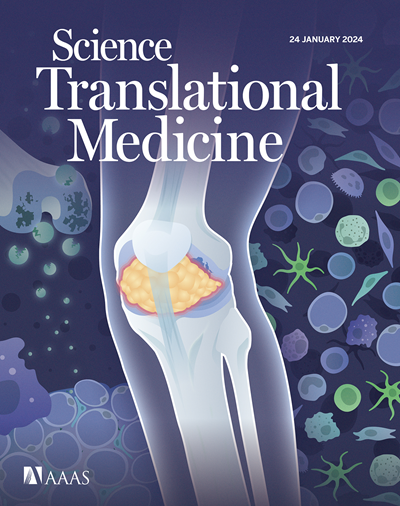A cationic polymer drives glycosaminoglycan assembly and secretion for preclinical osteoarthritis therapy
IF 14.6
1区 医学
Q1 CELL BIOLOGY
引用次数: 0
Abstract
Osteoarthritis (OA) affects nearly 500 million people worldwide and is characterized by an irreversible loss of glycosaminoglycans (GAGs) at articular cartilage surfaces, which are essential in maintaining cartilage mechanical properties and chondrocyte phenotypes. Despite advances, preserving cartilage GAGs and controlling their turnover in living cells remain challenging. On the basis of the hypothesis that GAGs can interact with cationic molecules, we demonstrated a cost-effective strategy to increase human cartilage GAGs using a cationic polymer hexadimethrine bromide (HDMBr). HDMBr promoted chondrogenesis of mesenchymal stem cells by attracting pericellular GAGs and up-regulating vesicle formation, leading to increased matrix secretion. HDMBr also acted like a molecular assembler to promote the assembly of chondroitin sulfate (CS) into highly concentrated condensates during intracellular trafficking, resulting in more efficient GAG secretion. HDMBr was then evaluated as a potential therapeutic in two animal models. In a rabbit model of large cartilage defects, HDMBr promoted the intrinsic regeneration of GAG-rich hyaline-like cartilage and improved tissue integration. In a rat model of OA, low-dose HDMBr treatment increased cartilage thickness, supported cartilage matrix homeostasis, and supported cell-based therapy, reducing OA damage as compared with other tested clinical treatments. Overall, this study introduces a cost-effective GAG manipulation approach to cartilage repair and joint preservation, offering insights into the mechanisms of cell-material interactions.
一种阳离子聚合物驱动糖胺聚糖组装和分泌用于临床前骨关节炎治疗
骨关节炎(OA)影响全球近5亿人,其特征是关节软骨表面糖胺聚糖(GAGs)的不可逆损失,这对维持软骨力学性能和软骨细胞表型至关重要。尽管取得了进展,但保存软骨gag并控制其在活细胞中的转换仍然具有挑战性。基于GAGs可以与阳离子分子相互作用的假设,我们展示了一种使用阳离子聚合物六己甲基溴(HDMBr)来增加人体软骨GAGs的成本效益策略。HDMBr通过吸引细胞周GAGs和上调囊泡形成,促进间充质干细胞软骨形成,导致基质分泌增加。HDMBr还像分子组装器一样,在细胞内运输过程中促进硫酸软骨素(chondroitin sulfate, CS)组装成高度浓缩的冷凝物,从而更有效地分泌GAG。然后在两种动物模型中对HDMBr作为潜在的治疗方法进行了评估。在兔大软骨缺损模型中,HDMBr促进了富含gag的透明样软骨的内在再生,并改善了组织整合。在OA大鼠模型中,与其他临床试验治疗相比,低剂量HDMBr治疗增加软骨厚度,支持软骨基质稳态,支持细胞治疗,减少OA损伤。总的来说,本研究引入了一种具有成本效益的GAG操作方法来修复软骨和保护关节,为细胞-物质相互作用的机制提供了见解。
本文章由计算机程序翻译,如有差异,请以英文原文为准。
求助全文
约1分钟内获得全文
求助全文
来源期刊

Science Translational Medicine
CELL BIOLOGY-MEDICINE, RESEARCH & EXPERIMENTAL
CiteScore
26.70
自引率
1.20%
发文量
309
审稿时长
1.7 months
期刊介绍:
Science Translational Medicine is an online journal that focuses on publishing research at the intersection of science, engineering, and medicine. The goal of the journal is to promote human health by providing a platform for researchers from various disciplines to communicate their latest advancements in biomedical, translational, and clinical research.
The journal aims to address the slow translation of scientific knowledge into effective treatments and health measures. It publishes articles that fill the knowledge gaps between preclinical research and medical applications, with a focus on accelerating the translation of knowledge into new ways of preventing, diagnosing, and treating human diseases.
The scope of Science Translational Medicine includes various areas such as cardiovascular disease, immunology/vaccines, metabolism/diabetes/obesity, neuroscience/neurology/psychiatry, cancer, infectious diseases, policy, behavior, bioengineering, chemical genomics/drug discovery, imaging, applied physical sciences, medical nanotechnology, drug delivery, biomarkers, gene therapy/regenerative medicine, toxicology and pharmacokinetics, data mining, cell culture, animal and human studies, medical informatics, and other interdisciplinary approaches to medicine.
The target audience of the journal includes researchers and management in academia, government, and the biotechnology and pharmaceutical industries. It is also relevant to physician scientists, regulators, policy makers, investors, business developers, and funding agencies.
 求助内容:
求助内容: 应助结果提醒方式:
应助结果提醒方式:


